Featured Projects
TRANSITION FROM SDI TO IP in Dogan TV Holding

For more than 10 years national Turkish broadcaster Dogan TV has been working with Cinegy. In 2003 Dogan TV’s initiative and forwardminded team decided to organize tapeless archive for their production purposes. After the successful implementation of scalable and hardware-independent Cinegy archive and MAM solutions, Dogan proceeded further and built a tapeless production workflow based on a standard office IP network including newsroom, ingest, and playout automation services.
As the time came to transition from SD SDI to HD SDI, Dogan calculated the costs for the transformation, anticipated their future workflow, and decided to migrate to an IP infrastructure as it was seen as cost-effective, less-cumbersome, and more scalable. The Dogan and Cinegy team collaborated on the principles and functionality of the IP-based live broadcast solution and finally began development of the IP-based live workflow as an extension to an integral part of the existing Cinegy solution.
As a result, by the end of the 2015, Dogan TV finished its transition to a full IP-based broadcasting and production workflow with only remnants of SDI in its studios. Today, Dogan TV is the only national broadcaster in the world whose broadcasting and production workflows are fully IP operated.
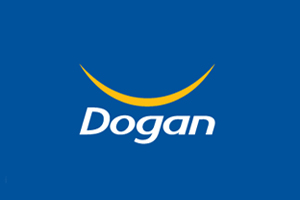 |
“December 2015 marked our eleventh anniversary with Cinegy and our relationship has been a great success for the last years.” Hasan Kiragi, Director of Broadcast Operations at Dogan TV Holding |
Replacing aging SDI-based infrastructures with IP-based infrastructure technology has become an increasingly popular choice among broadcasters seeking to improve workflow efficiency and cut costs.
We have asked Hasan Kiragi, Director of Broadcast Operations at Dogan TV Holding, to tell us about their successful transition from an SDI to IP workflow.
Cinegy: Why did you decide that you need to migrate from SDI to IP?
Hasan Kiragi: Towards the end of 2007, we started the D-Smart PayTV satellite platform project as a new business within Dogan TV Holding. The D-Smart Platform planned to have movie and drama channels as well as live sports, music channels, and some retransmit channels. The total number of channels planned to be on-air was more than 40 to start with. As was the standard way of implementing a TV infrastructure, we first prepared a technical project based on HD-SDI technology with lots of SDI distribution, signal processing equipment, very large SDI routers, and SDI multiviewers. As usual, the system design based on SDI was bulky, inflexible, costly, and not easy to operate or maintain. At that point, based on our four years of IT-based broadcast experience for file based workflows with Cinegy solutions, we realized that it was possible to move broadcast quality live video operations to IP. So we contacted Cinegy and discussed the possibility of such a development and shared with them the basic modules and functionality of the IP-based live broadcast solution we had in mind. After some discussion, it was decided that the project was feasible and affordable. We then began the development of IP-based live workflow as an extension to, and an integral part of, the existing Cinegy solution.
C: How long did it take from decision to implementation? What challenges have you met?
HK: We started using some modules of the system in the middle of 2009. It took two-to-three-years to have the whole solution ready as a live video broadcast system. The basic source, destination, and routing workflow of live SDI video is not that different with a live IP infrastructure, but the biggest difference was that we did not have a baseband video anymore that we could physically hold and patch, which was unusual, but a welcome change for our video technicians and engineers.
C: Could you please define the possible steps of transition from SDI to IP operations?
HK: Firstly, you have to get your signals on an IP domain. If you have a studio connected to the external world, its outputs should be sent on an IP domain and IP signals should be received on a SDI domain. To achieve this, you need to replace your old equipment with new devices that are capable of live IP streaming (DVB compliant) or you need to use gateways converting the SDI signal to IP and vice versa.
The next step is just implementation. All you need is to choose appropriate network switchers and build a reliable broadcastcapable network. Depending on the project complexity you may have some extra reasons for building a robust broadcast operation. In Dogan, we have two multicast networks working in parallel, so each source to our system simultaneously pushes IP streams in both networks in each destination. The Cinegy Multiviewer, Ingest and Playout machines are connected to both networks and simultaneously get the multicast streams. If you have deployed an IP network, you don’t have an SDI signal anymore and you can’t patch it from some point to another point by just connecting BNC cables. If something goes wrong in the network you are stymied. That’s why we implemented parallel network switches from different brands. If one brand fails we failover to the other one.
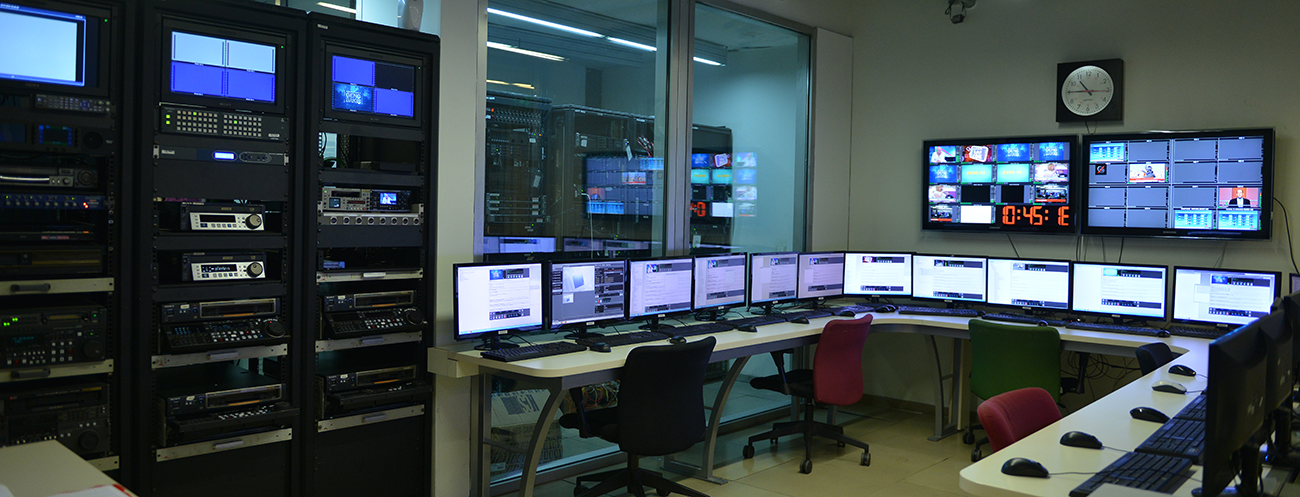
C: Could you tell us a bit more about the problems that Cinegy solves for you?
HK: No dependency on any proprietary hardware and format technology; freedom to use any standard IT equipment; and a flexible and scalable system design are what we essentially benefit from with Cinegy’s filebased video and IP solutions.
C: Regarding cost and operational management, have you noticed an improvement?
HK: For daily live broadcast operations there was no big difference. The improvements were on technical layouts that give us the potential for cost effective and flexible design. For example, we do not have to worry about live signals, neither as an input port number nor output port number for the routing; nor do we have to lay down thousands of meters of video cables to carry the live signals. We can carry hundreds of live video signal on a single 10gbps network port.
C: In what way did the process of migration from SDI to IP influence the people working at Dogan?
HK: At the operational level, there were no big differences for video technicians and engineers, they just learnt how to set up and operate the related software. which was a straightforward and easy process for those familiar with a software-based IT approach. For others it took a little more time, but even then the learning curve was short because the software is so intuitive. Because our broadcast chain now relies on IT systems, we reorganized our technical department to reflect those changes. Prior to the change, we had broadcast engineers with just enough knowledge of IT systems, and IT engineers with just enough knowledge of broadcast systems and workflows. Now, with the help of Cinegy, we have a technical department that is very conversant in both worlds. Our transition from SD to HD was transparent, again due to Cinegy, and our move from cassette to tapeless, and SDI to IP, were also easy because our technical people knew how to make the transition as a group.
C: Could you please provide an overview of your Cinegy system?
HK: All of our workflows (except for studio production) – recording, editing, archiving, playout, live signaling, graphics and insertion, and offline editing of the news program – are all based on Cinegy and IP-technologies.
We have 440 concurrent users of Cinegy Desktops and about 800 users in total. We have a 5 Petabyte archive and 260 TB of storage for production purposes. All important materials are also copied and transferred to our Ankara Disaster site. 25 ingest stations enable us to work with live records, IP streams and the remains of SDI signals. There are about 100 playout servers (redundant playout included) in our master control rooms for our major (Kanal D, CNN Türk) and satellite channels. On the production site we have about 30 studio playout servers for our 11 studio production locations. 50 IP multicast gateways convert SDI signals to IP and IP to SDI.
We also have Cinegy IP-tools to manage, monitor, and control all IP-streams in our workflow.
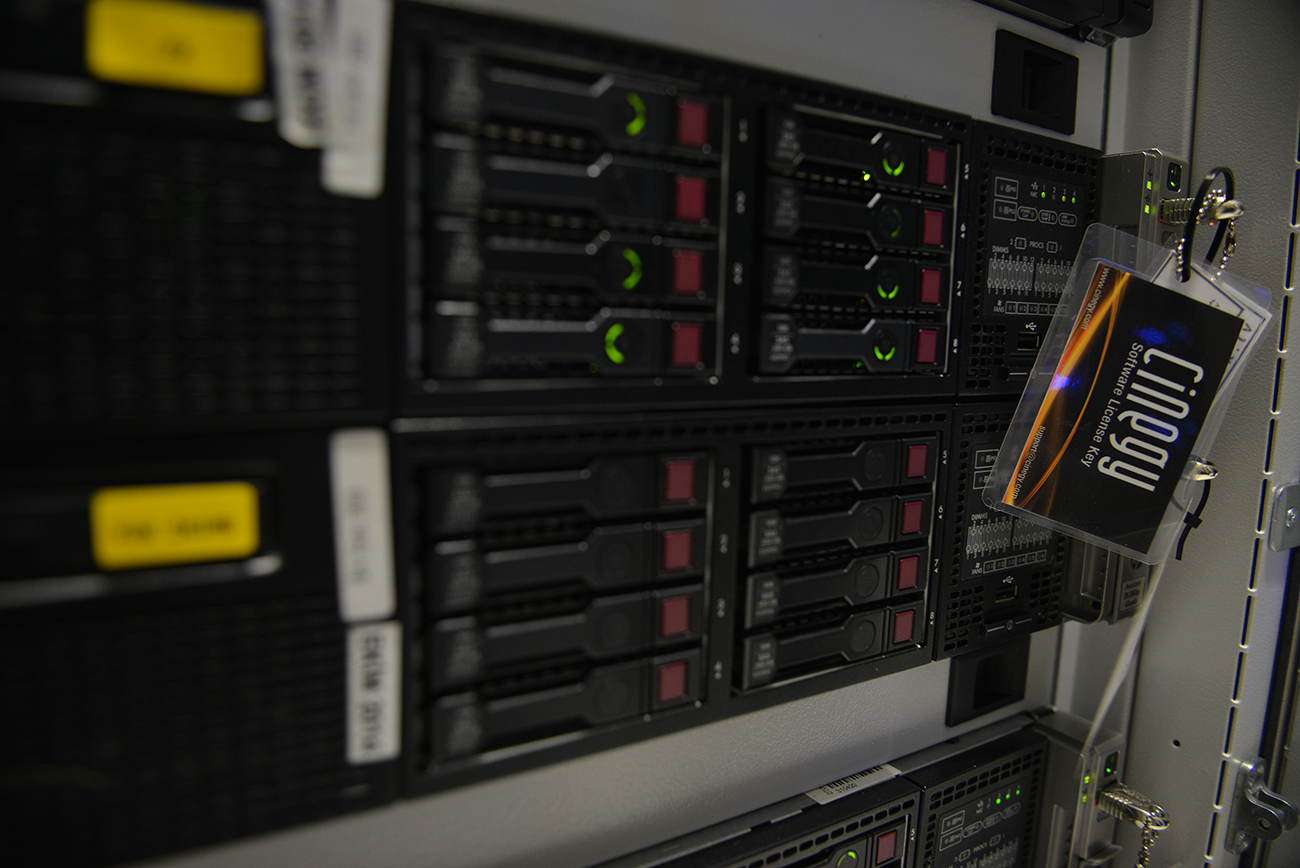
C: How many networks do you have? Do you use separate networks for video streaming?
HK: We have three separate networks that are completely isolated and all have full redundancy. One of them is used for file-based video operations and our office network. Another two networks that work in active/active operation are dedicated to live broadcast video operations and for failsafe operation.
C: Could you tell us about the disaster recovery systems in the new building?
HK: We have a scaled down Cinegy system in our Ankara location. We keep all of our file-based archive copies as a disaster backup and have limited playout and uplink functionality there as well.
C: How do Dogan News Agency (DHA) and D Productions use the new IP-environment?
HK: Live video operations, including news feeds from SNG trucks of DHA, monitoring of satellite video feeds and DHA news playout satellite feed completely runs on a live IP environment. D Productions utilize the live IP site to simultaneously record from multiple cameras (up to eight) from the same production studio.
C: Do you have any remaining SDI equipment or infrastructure? Do you use tape anywhere in your system?
HK: We still have SDI operations in our studio productions (SDI based cameras, studio vision mixers, studio graphic equipment, etc.) and some of our satellite encoders have SDI input. But even for that equipment and those locations, live signal routing is performed through Cinegy Live IP networks and the signal is converted to SDI via IP-SDI gateways at the last point that it is needed. We don’t use any tape in Dogan TV center. We only have some HDCAM tape machines in case some HDCAM tapes arrive in our center from third parties.
C: Do you use 4K material in Dogan?
HK: Not yet. We have plans to use it for OTT services soon. I suppose that would be 4K music clips from third parties. We have just started testing this technology.
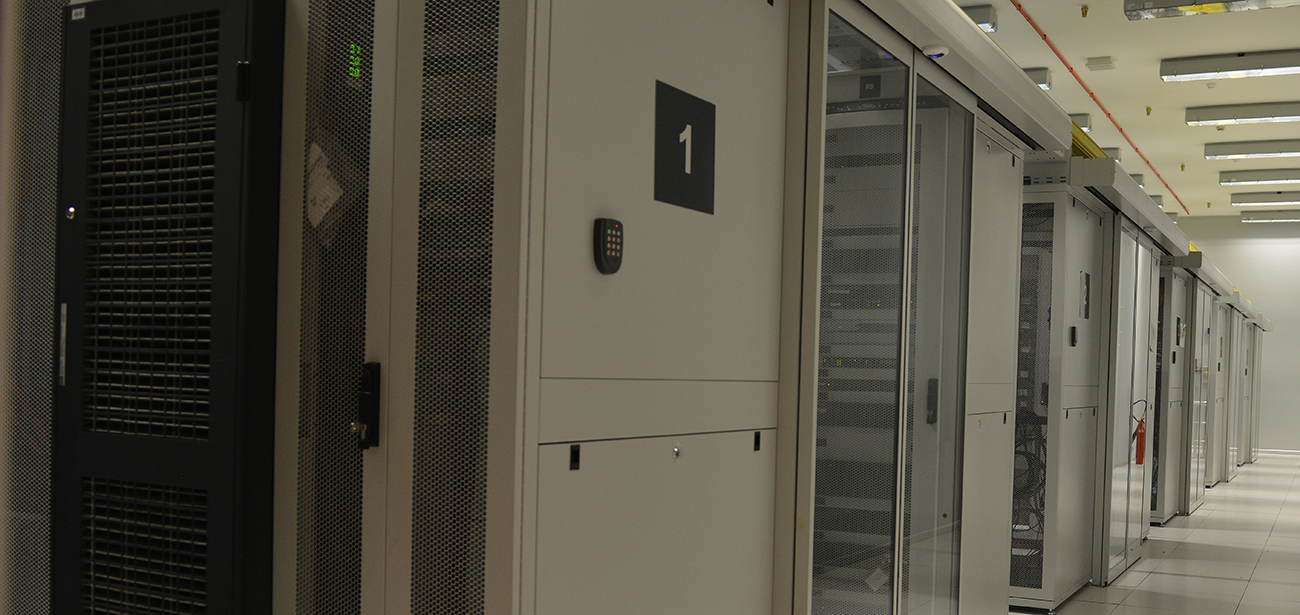
C: What about cloud technologies? Do you use it?
HK: We already have a lot of virtualization installations. Some of the Cinegy services already run in virtual environments and we are already testing and augmenting the Cinegy Air operations on virtual servers. For example, we sell our content to the third parties, so we have to prepare the formats of those videos depending on the request. We use Cinegy Convert running on the virtual services for it. We also have some services for 24/7 recording and ingesting of some TV channels, news feeds, and at least a couple of channels running simultaneously on a single server with virtualization in test mode. And we have GPU virtualization in this scenario also.
C: What are your plans for the future and Cinegy?
HK: We have a very innovative and productive partnership with Cinegy, now for more than 12 years. I expect, being a leading IT-based broadcast technology R&D company, that Cinegy will continue to cover more areas of broadcast technology and continue to improve existing products.
DEPLOYMENT OF CINEGY IN DOGAN
- 52 channels in SD and HD, VoD and OTT services
- 800 Installed Cinegy Desktops of which 440 users work concurrently (in Istanbul and Ankara)
- 5 SDI (SD/HD) and 20 IP Multicast Cinegy Ingest Station
- 50 IP Multicast Gateways to convert SDI to IP and IP to SDI
- 12 IP Multicast based VideoWalls for video monitoring with Cinegy Multiviewer
- 30 Studio Playouts and 52 channel playouts (29 SD and 23 HD) with Cinegy Air Pro
- Production storage 260 TB, Archives 5200 TB in Istanbul in Cinegy Archive
- Disaster Recovery Site in Ankara: 3800 TB archived materials, connected to Istanbul via Metro Ethernet
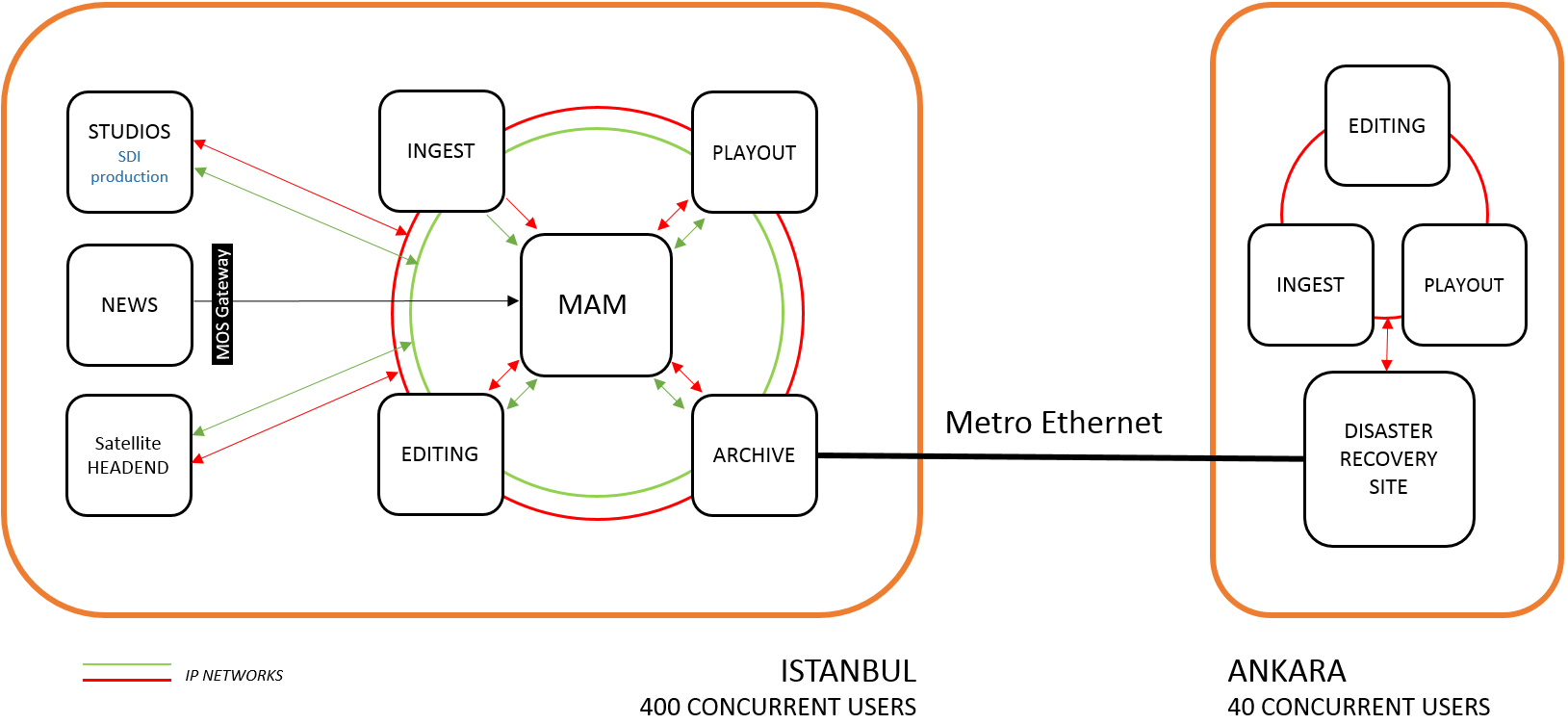
MAIN STEPS OF MIGRATING FROM SDI TO IP
Build a tapeless production workflow.
With the help of a standard IP-based office network to implement a common infrastructure in all departments and organize tapeless workflow – archiving the assets, logging, editing and having unlimited access to all created material, not forgetting ingest and playout. Transforming tapebased assets into digital media gives unlimited possibilities for storing, retrieving and repurposing media, creating new opportunities for extracting value from them.
Educate your people.
Moving to an IP-based workflow can be achieved by cross-training broadcast staff in IT technologies and cross-training IT staff in broadcast technologies. Cinegy tools provide a means for creative staff accustomed to older styles of working to expand their capabilities because of the flexibility of IP broadcast infrastructures compared with SDI.
Understand what you need to change in your live broadcast signaling chain.
Estimate your existing SDI infrastructure and define critical parts of it to be replaced. Usually the most important elements are matrix switchers, studio mixers, monitoring devices, SDI cabling, etc.
Deploy a redundant broadcast-capable network.
As broadcast-quality video signals require full bandwidth, it is recommended to build a separate network for video signal distribution. Depending on your requirements it could be reasonable to build two or three unicast/multicast networks working in parallel and utilize different vendors’ equipment for more redundancy. Standard IT networking equipment is considerably cheaper than equivalent SDI infrastructure, and is also much more easily extended.
Get all of your signals on an IP domain.
To achieve this you need to replace your old SDI equipment with new devices that are capable of live IP streaming, or use software gateways to convert SDI signals to IP and vice versa.
You are now fully IP-operational!
MORE ABOUT KEY DOGAN TV CHANNELS

Kanal D is the largest Turkish broadcaster – their programs are broadcast all over Europe via satellite. Cinegy is being used throughout the whole workflow – to prepare news, sports, entertainment programs, archiving and playout to air.
CNN Türk – 24 hour news channel and CNN International affiliate, CNN Türk uses Cinegy’s MOS Protocol integration with the Cinegy Desktop for their News production solution. Cinegy Air is used to playout to air, as well as scheduled and news playout.
DreamTV (the Turkish equivalent of MTV) is a 24/7 international satellite music channel producing music programs, broadcasting live concerts which focuses both on Turkish and international artists, and Dream Türk, which focuses on Turkish artists makes great use of the Cinegy eXtreme post-production tool. Cinegy eXtreme directly links into the Cinegy Archive asset management system for immediate access to all clips and projects. Cinegy eXtreme is an effects and post production tool mostly used to add elaborate graphics layers.
DHA – Dogan News Agency has about 150+ correspondents around the world, remotely uploading to the Cinegy system via FTP via Internet or even mobile phone the latest breaking news. Live video operations, including news feeds from SNG trucks of DHA, monitoring of satellite video feeds and DHA news playout satellite feed completely runs on IP live environment. Material is manually or automatically ingested into the system. DHA also uses the Cinegy system to playout satellite feeds to its customers around the world.
D Productions – one of the leading production companies in Turkey, produces TV series, programs, movies and providing movie distribution services. D Productions uses Cinegy IP tools to simultaneous recording of multiple cameras (up to 8) from the same production studio.
D-Smart is one of the Turkey’s leading digital broadcasting platforms (with more than 1 mio Pay TV and about 400 thou ADSL subscribers) offered as set-top-box. D-Smart users can watch about 240 channels, of which 62 are HD quality (including national and satellite channels broadcasting on Türksat) as well as live TV and content access services via the internet. Electronic Programming Guide (EPG) and conditional Access and also traffic management were driven with the help of Cinegy Route.
OVERVIEW
IP infrastructure
All operations in Dogan Television Center – ingest, MAM and archiving, news and different programme editing, signal routing, monitoring and playout – are now produced in a standard IP office network with the help of network switchers. Even SDI signals from nine Dogan studios are converted to RTP and operated as IP-streams among the other 500 IP streams existing on the Dogan network. To enable proper and secure functioning of IP-based broadcasting workflow, two networks were built at Dogan. Equipment by different manufactures are used for more redundancy. Cinegy Multiviewer, Ingest and Playout machines are connected to both broadcast networks and simultaneously receive the multicast streams.
Live broadcast signalling
Live SDI signals from Dogan studios first go to the SDI-IP gateway, and after that simultaneously to Cinegy Ingest, master control (Cinegy Air) to playout on-air and Cinegy Multiviewer for monitoring. If it is not a live broadcast, the live SDI-IP signal is first ingested, then edited, then broadcast, and archived. To convert SDI signals to IP and IP to SDI 50, IP multicast gateways are used.
Ingest
On standard IT hardware Cinegy ingests in Dogan a wide variety of inputs and creates about 475 hours of ingested material a day, 14,230 hours a month. All materials are ingested in three different qualities at the same time (broadcast, edit, lowbit/web). Broadcast and edit copies can be used for redundancy, if needed.
20 ingest seats encode IP multicast and unicast streams coming from all Dogan workflows.
Five seats are used to ingest SDI signals.
The rest of the ingested sources are video files from different media such as B2C2, SxS, P2, XDCAM, or from the third parties (MPEG, AVI, QuickTime, Windows Media, H.264, etc).
Cinegy software at Dogan also supports batch ingest and conversion of news agency feeds.
Desktop Clients and MAM
Cinegy Desktop is used by about 800 users, 440 of which (400 in Istanbul, 40 in Ankara) work concurrently on a standard office network.
All users are able to search, browse, log, edit, locally record voice-overs, and do document management, EDL/AAF/XML file export according to their level of rights.
There are only two craft editing rooms left for general purposes for news and drama with Cinegy eXtreme and Adobe Tools (AE, Premier). Some craft editing users work with Cinema4D, Maya, AE, Max3DS and VizRT Editor for Kanal D and CNN Türk.
Archive
Cinegy Archive was the first Cinegy software product implemented at Dogan more than 10 years ago. Since that time its usage has constantly grown and as of now we have about 300,000 hours of archived video (5200 TeraBytes) at high capacity nearline storage area. For redundancy all important materials are also copied and transferred to Disaster Recovery Site.
Playout
The key concept of the Cinegy playout system at Dogan is a real-time, network service-based remote video operation via TCP/IP. The main channel playouts run on three parallel playout servers. Other channels have N+1 playout redundancy. The main channel playout servers run in sync mode with our Ankara disaster recovery site’s playout servers.
The entire system consists of 52 channels of playout Servers (29 SD/23 HD), 30 studio playout servers (HD) and 30 IT-based graphic systems.
The playout system at Dogan is capable of simulcasting HD/SD playout, SDI, IP, HTTP output, logo insertion and title overlays, and CG branding solution with the help of Cinegy Type.
For signal monitoring, 12 IP multicast based video walls are driven by Cinegy Multiviewer software.
Disaster Recovery Site
Our disaster recovery site is 400 km away from our main facility in Istanbul and connected via a Metro Ethernet Disaster Recovery Site in Ankara that provides not only hot stand-by functionality in case a catastrophic event occurs, but archives all important material of Dogan TV holding (about 3800 Terabyte).
Newsroom
The Dogan newsroom is fully tapeless and successfully integrated in an IP environment. The two biggest channels in Dogan Holding – Kanal D and CNN Türk – are included with newsrooms for more than 100 people, each using Cinegy software to interoperate with their own EGS news system with the help of MOS Protocol.
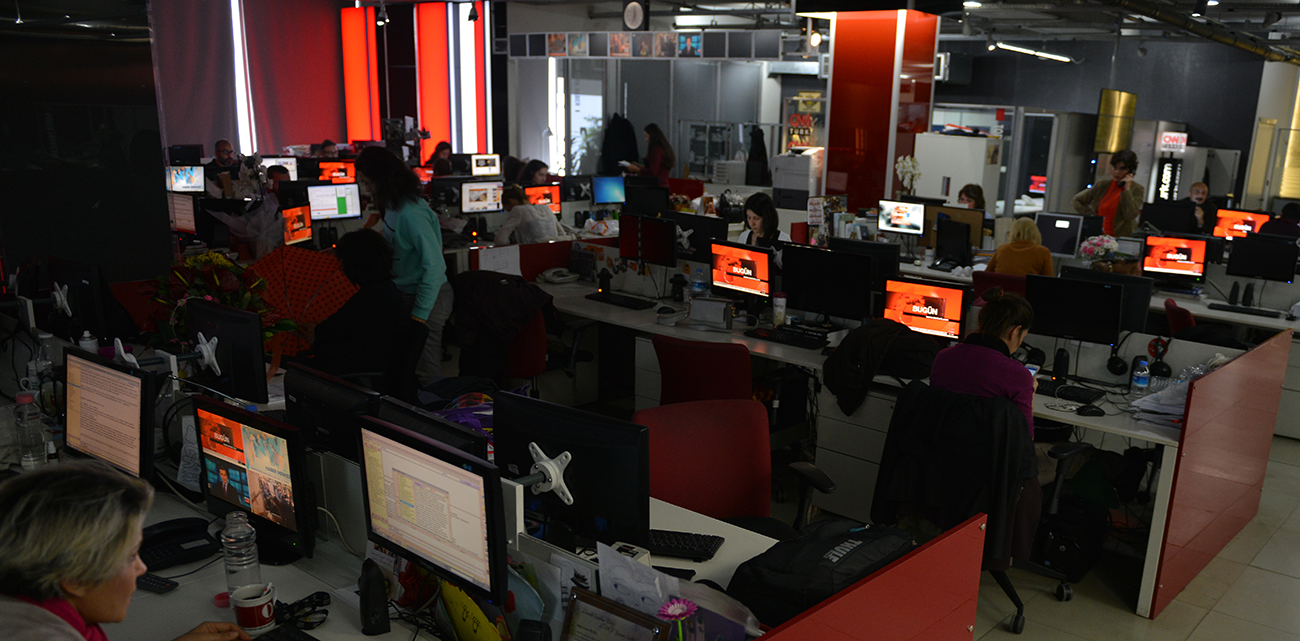
TECHNICAL INFORMATION
Network
2 parallel multicast Ethernet networks (HUAWEI and AVAYA) for broadcast operations, AVAYA-Nortel passport switches. All servers and playout channels are working on gigabit Ethernet.
Playout
HP DL380 G8 Server, 2x Intel Xeon E5-2665 @ 2.40 GHz, 16-32 GB RAM, Windows 2008 R2 Standard, 300 GB System Volume (Raid 1) – SAS Disks, 1.3 TB Cache Volume (Raid5) – SAS Disks, NVIDIA Quadro K600 Graphic Card.
Ingest
HP DL380 G7 Server, 2x Intel Xeon X5680 @ 3.33 GHz, 12 GB RAM, Server 2008 R2 Standard, NVIDIA Quadro K600 Graphic Card, 300 GB System Volume (Raid-1).
Desktop
Dell Precision T1650, Intel Xeon E3-1240 V2 @ 3.40 Processor, 6 GB RAM, NVIDIA GT430/Quadro 600 Graphic Card, Sata3 HDD / SSD.